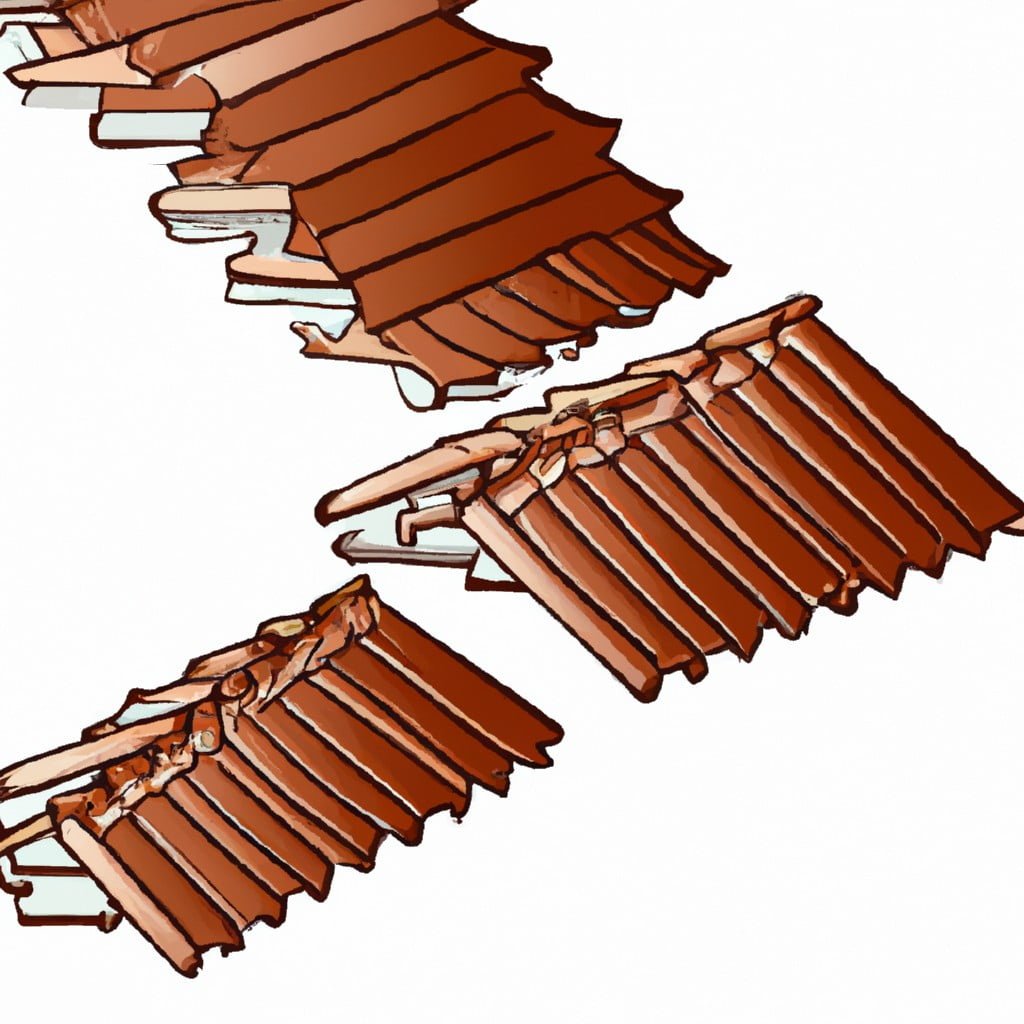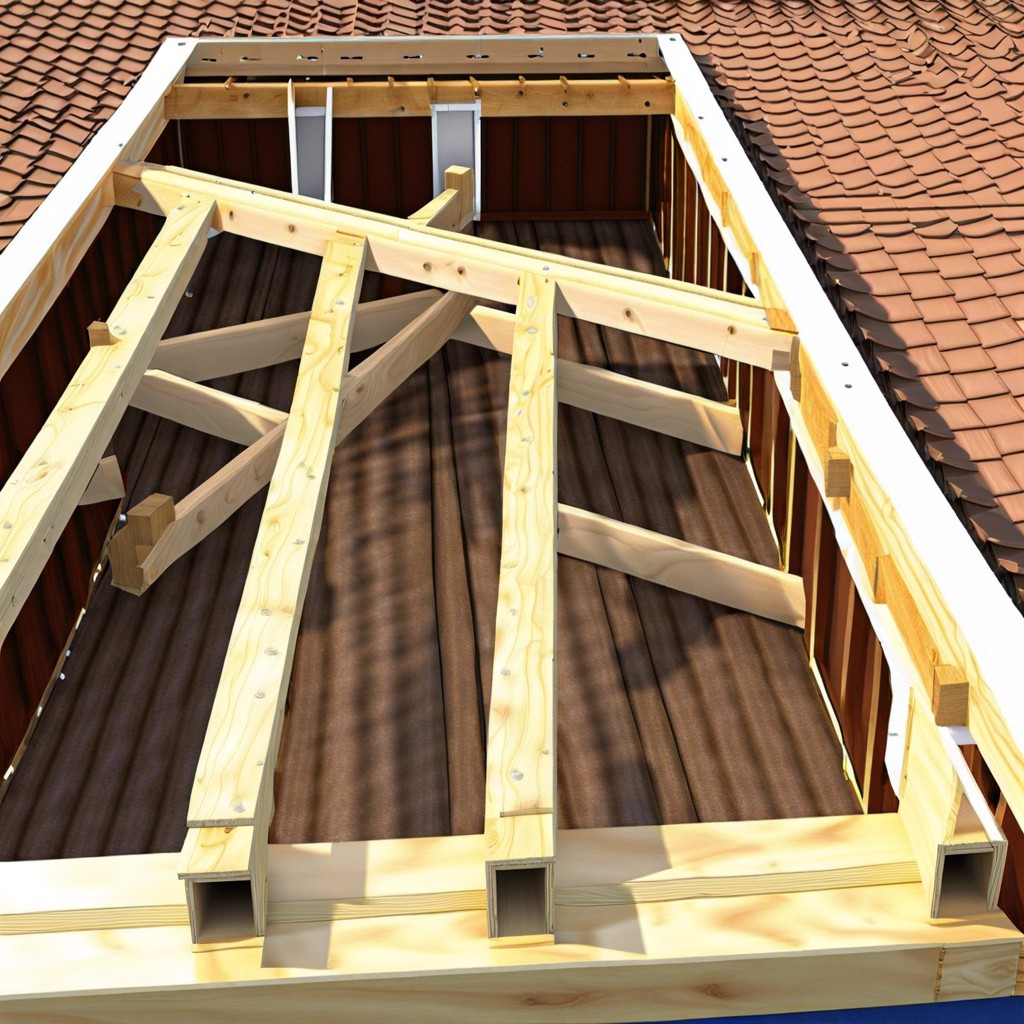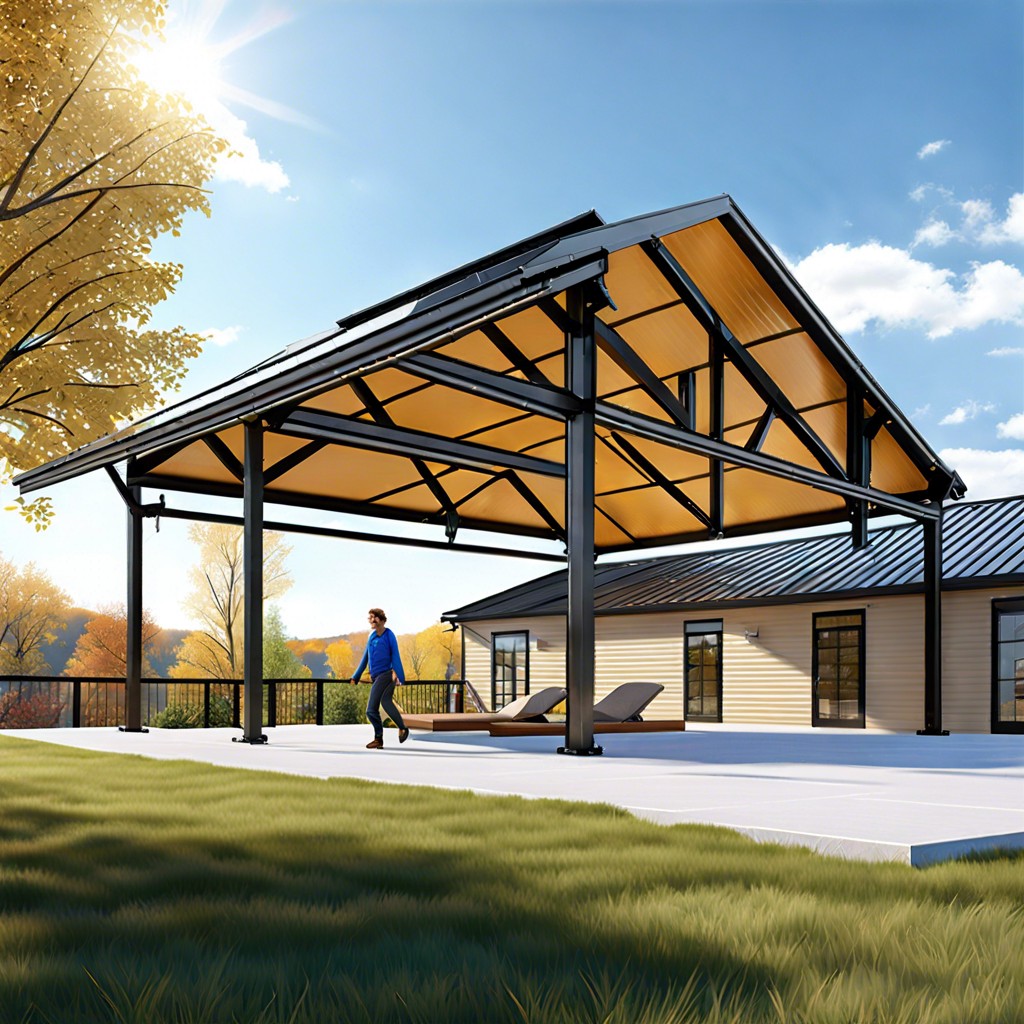Last updated on
Answer: Yes, you can paint roof tiles. However, it is essential to use appropriate paint and follow proper preparation and application techniques for long-lasting results.
Are you tired of the dull and faded appearance of your roof tiles? Do you want to give your home a fresh look without spending a fortune on a new roof? Well, we have good news for you! Painting your roof tiles can be an excellent solution. But before you grab a paintbrush and start painting away, there are some things you need to consider.
In this article, we’ll explore the question “Can You Paint Roof Tiles?” and provide all the information you need to know before embarking on this project. So sit back, grab a cup of coffee and let’s dive into the world of painted roofs!
Can Roof Tiles Be Painted?

Roof tiles can be painted, but it’s important to note that not all types of roof tiles are suitable for painting. The most common types of roof tiles include clay, concrete, slate and metal.
Clay and concrete tile roofs are the most popular roofing materials in many parts of the world due to their durability and aesthetic appeal.
Painting your roof tiles is an excellent way to give your home a fresh look without having to replace them entirely. However, before you start painting your roof tiles yourself or hire a professional roofer for this job, there are some things you need to consider.
Firstly, check with the manufacturer or supplier if they recommend painting their specific type of tile as some may void warranties if painted over. Secondly ensure that any repairs needed on broken or damaged areas have been completed prior as these will affect how well paint adheres onto surfaces.
Lastly choosing appropriate paint is crucial; using regular house paints can cause damage by trapping moisture under layers leading eventually lead peeling off which could result in costly repairs down line.
Roof Tile Materials
Each material has its unique characteristics that affect the durability and appearance of your roof. Clay tiles are a popular choice due to their natural beauty and longevity; they can last up to 100 years with proper maintenance.
Concrete tiles are also durable but less expensive than clay ones; they come in different shapes and colors that mimic other roofing materials like wood or slate.
Slate is another long-lasting option for roofing material; it’s fire-resistant, eco-friendly, low-maintenance but more expensive than other options. Metal roofs have become increasingly popular due to their energy efficiency properties as well as being lightweight yet strong enough to withstand harsh weather conditions.
Benefits of Painting Roof Tiles
One significant advantage is that it can help to extend the lifespan of your roof by protecting it from weather damage, UV rays, and other environmental factors. Painting can also improve energy efficiency by reflecting sunlight and reducing heat absorption into the house.
Another benefit is that painted roofs require less maintenance than unpainted ones since they are less prone to moss or lichen growth. This means you’ll spend less time cleaning and repairing your roof over time.
Moreover, painting a tile roof provides an opportunity for homeowners to customize their homes’ look without having to replace their entire roofing system entirely. You have a wide range of colors available when choosing paint for tiles so you can match them with any exterior color scheme or style preference.
Lastly, repainting old faded roofs before selling a property could increase its value significantly as potential buyers will be attracted by its fresh new look.
The Pros and Cons of Repainting Your Tile Roof
However, before you start painting, it’s essential to weigh the pros and cons of repainting your tile roof.
One of the main advantages of repainting is that it can extend the life of your roof tiles by protecting them from weather damage such as UV rays, rainwater or hailstorms. Painting can help prevent moss growth on tiles which could cause water retention leading to leaks in some cases.
Another benefit is that you have more color options available than when choosing new roofing materials. You may want to change up the style or color scheme for aesthetic reasons without having to replace an entire roof structure.
On the other hand, there are also some downsides worth considering before deciding whether or not repainting is right for you. One potential disadvantage is that if done incorrectly (e.g., using improper paint), it could lead to further damage rather than protection against weather elements.
Moreover, depending on how old and damaged they are already; sometimes replacing old tiles with new ones might be more cost-effective in terms of long-term maintenance costs compared with just painting over them. Lastly but not least important: Painting over cracked or broken tiles will only mask underlying issues temporarily instead fixing those problems permanently through replacement would ensure better structural integrity overall.
Choosing the Right Paint
The type of paint you choose will depend on several factors such as the material of your roof tiles and your local climate conditions.
For instance, if you have clay or concrete tiles, acrylic-based paints are a popular choice due to their durability and resistance to fading. On the other hand, metal roofs require specialized coatings that can withstand extreme temperatures and prevent rusting.
It’s also essential to consider color when choosing paint for your roof tiles. Lighter colors reflect sunlight better than darker shades which absorb heat more readily.
Therefore lighter colors may be a better option in warmer climates where energy efficiency is crucial.
Before purchasing any paint for your tile roofing project, consult with an expert roofer who can advise on what type of coating would work best for your specific needs based on factors like weather patterns in your area or potential environmental hazards like saltwater spray from nearby oceans or lakes.
Preparing Roof Tiles for Painting
This step is essential for ensuring that the paint adheres well and lasts longer. The first thing you need to do is clean the tiles thoroughly.
Remove any dirt, debris, moss or lichen from the surface of each tile using a high-pressure washer or a stiff-bristled brush.
If there are any broken or damaged tiles on your roof, replace them before starting with painting work. Also check if there are any loose mortar around ridge caps and hips; re-bedding & re-pointing may be required in such cases.
Once all repairs have been made and cleaning has been done successfully let your roof dry completely before proceeding further with painting work. After cleaning & drying process is complete apply an appropriate primer coat on top of cleaned surfaces which will help in better adhesion of paint onto tile surface as well as provide protection against weather elements like UV rays etc.
Moss & Lichen Removal
They not only make your roof look unsightly but also cause damage to the tiles over time. Before painting your roof tiles, it is essential to remove any moss or lichen growth.
There are several ways to remove moss and lichen from a tile roof. One method is using a solution of bleach and water applied with a soft-bristled brush or low-pressure sprayer.
However, this method can be harmful to plants surrounding the house if not done correctly.
Another option is using eco-friendly products specifically designed for removing moss and algae from roofs without damaging the environment or harming nearby vegetation.
It’s important to note that removing moss & lichens requires expertise as improper removal techniques may lead you into more trouble than before; hence it’s best left for professionals who have experience dealing with such issues.
High Pressure Cleaning
It involves using a high-pressure water jet to remove dirt, grime, moss, and other debris from the surface of the tiles. This process not only improves the appearance of your roof but also ensures that paint adheres well to the surface.
However, it’s important to note that high-pressure cleaning can be damaging if not done correctly. The force of water can dislodge loose or damaged tiles and cause leaks in your roof.
Therefore it’s crucial to hire a professional roofing contractor who has experience with this type of work.
A skilled roofer will know how much pressure is safe for each type of tile material and will take precautions such as covering gutters before starting work on your roof. They’ll also use appropriate detergents or chemicals along with hot water at specific temperatures depending on what needs removing from the tile surfaces.
Broken Tile Replacement
Broken tiles can cause leaks and damage the structure of your home. Replacing a tile is not as complicated as you might think, but it does require some skill and experience.
Firstly, identify the broken tile by looking for any cracks or missing pieces on the surface of your roof. Once you have located the damaged tile(s), carefully remove them using a chisel and hammer.
Next, clean out any debris from under where the old tile was removed to ensure that there is no dirt or dust left behind that could interfere with proper installation of new tiles.
Then place a new replacement tile in its position ensuring that it fits snugly into place without leaving gaps between adjacent tiles which could allow water penetration during heavy rainfalls.
Secure each replacement piece with roofing nails driven through pre-drilled holes in both sides (top & bottom) so they don’t move around when exposed to wind gusts etc., then apply sealant around edges if necessary depending on type/brand used – follow manufacturer instructions closely!.
Re-bedding & Re-pointing Tiles
Over time, the bedding mortar that holds the tiles in place can deteriorate due to weather conditions or natural wear and tear. This can cause the tiles to become loose, which may lead to leaks or even structural damage if left unattended.
Re-bedding involves removing old mortar from under each tile and replacing it with new cement-based bedding material. Re-pointing is a process of repairing any cracks or gaps between adjacent tiles by filling them with fresh pointing material.
Both these processes require expertise as they involve working at heights on a sloping surface while handling heavy materials such as cement mixtures. It’s essential to hire an experienced roofing professional who has proper safety equipment and tools required for this job.
By re-bedding and re-pointing your roof before painting, you ensure that all your roof components are secure, stable, and ready for paint application.
Gutter Cleaning
Clogged gutters can cause water damage to the roof and walls, leading to costly repairs. Therefore, it’s crucial to inspect and clean them regularly.
Cleaning the gutter is a simple task that you can do yourself or hire a professional for better results. If you decide on DIY cleaning, make sure you have all the necessary tools such as gloves, ladder or scaffold tower (depending on how high your house is), bucket with handle & scoop attachment for removing debris from inside gutters.
Start by removing any large debris like leaves or twigs using a scoop attachment tool before flushing out smaller particles with water from a hosepipe attached at one end of downspout while holding onto other end tightly so no leaks occur during this process!.
Valley Check
Valleys are the areas where two sections of a roof meet at an angle and form a V-shaped channel. These channels collect rainwater and direct it towards gutters or downpipes.
Over time, valleys can become damaged due to weathering or improper installation. If they’re not functioning correctly, water can seep through them and cause leaks inside your home.
To avoid this problem, you should have a professional roofer perform a valley check before painting your roof tiles. They will inspect the condition of the valleys and determine if any repairs need to be made.
If there is damage present in these areas during inspection by professionals like us at XYZ Roofing Company Ltd., we’ll repair them before proceeding with painting work on tile roofs so that you don’t have any issues later on after completion of work.
Painting Clay Roof Tiles
They come in various shapes, sizes, and colors that can complement any architectural style. If you have clay roof tiles on your home, painting them can be an excellent way to enhance their appearance while also protecting them from the elements.
When it comes to painting clay roof tiles, there are some essential things you need to know. First of all, not all types of paint will work on this material.
You need a high-quality acrylic or elastomeric paint that is specifically designed for use on roofs.
Before applying the paint, make sure your clay roof tiles are clean and free from debris such as moss or lichen growths which could affect adhesion between the tile surface and coating layer leading eventually peeling off over time. It’s important also not only cleaning but repairing any broken or damaged tile before starting with repainting process since water infiltration may cause further damage if left unattended.
Another crucial factor when painting clay roofing is choosing the right color scheme that complements your home’s exterior design without clashing with other features like walls or windows frames.
Painting Concrete Roof Tiles
If you have concrete roof tiles, painting them can be an excellent way to enhance the appearance of your home. However, it is crucial to use the right type of paint that will adhere well to the surface and withstand harsh weather conditions.
When painting concrete roof tiles, it is essential first to clean them thoroughly using high-pressure water or chemical cleaning agents. This step ensures that any dirt or debris on the surface does not interfere with proper adhesion of paint.
After cleaning, allow sufficient time for drying before applying primer coat followed by two coats of quality acrylic-based exterior paint designed specifically for roofs. The primer helps in creating a smooth base while also improving adhesion between tile surfaces and topcoat.
It’s worth noting that when choosing colors for your painted concrete tile roofing project; lighter shades tend not only look great but also reflect sunlight better than darker ones which absorb more heat leading potentially higher energy bills during summer months.
Painting Slate Roof Tiles
However, over time, slate roofs can become faded or discolored due to exposure to the elements. Painting your slate roof tiles is an excellent way of restoring their appearance and protecting them from further damage.
When painting slate roof tiles, it’s essential to use a high-quality paint that will adhere well and provide long-lasting protection against weathering. Acrylic paints are often recommended as they offer excellent adhesion properties while also being flexible enough not to crack or peel when exposed to temperature changes.
Before painting your slate roof tiles, you must clean them thoroughly using a pressure washer or by hand with soap and water. Any moss or lichen growth should be removed carefully before applying the paint.
It’s important not only that you choose the right type of paint but also select colors that complement your home’s exterior design scheme while still providing adequate UV protection for your roofing material.
Painting Metal Roof Tiles
However, over time they can become faded or discolored due to exposure to the elements. Painting metal roof tiles is an excellent way of restoring their appearance and prolonging their lifespan.
Before painting metal roof tiles, it’s essential first to clean them thoroughly using a high-pressure washer or a wire brush. This will remove any dirt or rust that may have accumulated on the surface of the tiles.
Once cleaned and dried completely, you can apply a coat of primer specifically designed for use on metal surfaces before applying your chosen paint color. It’s important not to skip this step as it helps ensure proper adhesion between the paint and tile surface.
When choosing your paint color for metal roofing materials such as aluminum or steel panels/tiles make sure you select one that is suitable for outdoor use in harsh weather conditions like rainstorms with strong winds etc., so it doesn’t fade quickly under sunlight exposure over time.
Maintaining Painted Roof Tiles
Regular maintenance can help prevent damage and prolong the life of your roof. Here are some tips for maintaining painted roof tiles:
1. Clean Your Roof: Dirt, debris, and other contaminants can accumulate on your roof over time and cause damage if left unchecked.
It’s important to clean your painted tile regularly using a soft-bristled brush or low-pressure washer.
2. Inspect Your Roof: Regular inspections will help you identify any issues before they become major problems that require costly repairs or replacements.
3. Repair Damage Promptly: If you notice any cracks or chips in the paint on your tiled roofing system, repair them promptly with touch-up paint.
4. Trim Trees Near Your Home: Overhanging branches from trees near your home can scratch against the surface of the tiles causing scratches which may lead to peeling off of paint over time.
5. Hire Professionals for Maintenance Work: While DIY maintenance work might seem like an easy way out but hiring professionals who specialize in roofing services is always recommended since they have experience working with different types of roofs including those that are already coated with paints.
Pros and Cons of DIY Painting
While DIY painting can save you money on labor costs, there are some pros and cons to consider before taking on this project.
Pros:
- Cost savings: Doing the job yourself can save you a significant amount of money compared to hiring a professional.
- Sense of accomplishment: Completing a home improvement project like this can give you a sense of pride and satisfaction in your work.
- Flexibility: You have control over when and how the job gets done.
Cons:
- Safety concerns: Painting roofs requires working at heights which could be dangerous if proper safety measures aren’t taken.
- Lack of experience/knowledge: If not done correctly, DIY roofing projects could lead to costly mistakes such as using incorrect paint or improper preparation techniques that result in peeling paint or other issues down the line.
- Time-consuming process – Roof tile painting is time-consuming work. It will take longer than expected if it’s your first time doing it.
Ultimately, deciding whether or not DIY roof tile painting is right for you depends on several factors including skill level, available resources (tools & equipment), budget constraints among others.
Hiring a Professional Roofer
If you’re unsure about your ability to complete the job correctly or don’t have enough time and energy to do it yourself, hiring a professional roofer is an excellent alternative.
Professional roofers have years of experience in handling different types of roofs and know how to prepare surfaces for painting. They also use high-quality paints that are specifically designed for roofing materials, ensuring long-lasting results.
When choosing a professional roofer, make sure they are licensed and insured. Ask for references from previous clients and check their online reviews before making any commitments.
Although hiring professionals may cost more than doing it yourself initially, you’ll save money in the long run by avoiding costly mistakes that could lead to further damage or repairs down the line.
Costs and Savings of Painting Roof Tiles
The cost of painting roof tiles varies depending on several factors, such as the size and pitch of your roof, the type of paint used, and whether you choose to do it yourself or hire a professional roofer.
If you decide to tackle this project yourself, you’ll need to factor in the cost of materials such as primer, paint brushes or rollers, masking tape and cleaning supplies. On average DIY painting costs range from $500-$1 000 for an average-sized house with standard pitched roofing.
Hiring professionals will increase costs but also ensure that everything is done correctly. Professional painters have access to high-quality paints that are specifically designed for roofs which means they last longer than regular exterior paints.
They also have specialized equipment like pressure washers which make cleaning easier while ensuring no damage occurs during preparation work.
While there is an initial investment involved in repainting your tile roof professionally; it’s important not only because it saves time but also money over time by extending its lifespan up-to 10 years!.
FAQ
What paint can you use on roof tiles?
You can use water-based acrylic paints and latex paints on roof tiles, as they are generally suitable for most conditions.
Can you paint tiled roofs?
Yes, you can paint tiled roofs as it is an easy, inexpensive method to improve longevity and can save you from future stress and expensive repairs.
How long does paint last on roof tiles?
Roof paint can last for 15 years or more when using high-quality paint, proper application techniques, and adequate surface preparation.
Is it OK to paint roof shingles?
Yes, it is OK to paint roof shingles, as it is a relatively easy and budget-friendly process compared to re-shingling the roof.
What is the best method for applying paint to roof tiles?
The best method for applying paint to roof tiles is using an airless paint sprayer or a brush for a smooth and even coverage.
How does painting roof tiles affect their durability and performance?
"Painting roof tiles can improve their durability and performance by providing a protective layer against weathering and environmental factors."
What factors should be considered while choosing the right paint for different roof tile materials?</strong>
When choosing the right paint for various roof tile materials, factors such as durability, compatibility, weather resistance, and visual appeal should be considered.




